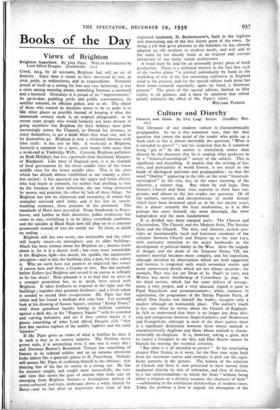Books of the Day
Views of Brighton
Brighton Aquatints. By John Piper. With an Introduction by Lord Alfred Douglas. (Duckworth. 2 IS.) UNTIL 1914, by all accounts, Brighton had still an air of festivity. Since then it seems to have increased in size, in civic pride, in ordinariness, and in respectability. Formerly proud of itself as a setting for free and easy behaviour, it was a siren among watering places, something between a mermaid and a barmaid. Nowadays it is proud of its " improvements," its up-to-date paddling pools and public conveniences, its satellite suburbs, its efficient police, and so on. The object of those who control its destinies seems to be to make it as like other places as possible instead of keeping it what the nineteenth century made it, an original playground : so in recent years people who would formerly not have dreamt of going anywhere but Brighton for their holidays have gone increasingly across the Channel, to Ostend for instance, to enjoy themselves, to get a drink when they want one, and to let themselves go. Brighton is now a reformed libertine with false- teeth: it has lost its bite. A week-end at Brighton, formerly a synonym for a spree, now means little more than a week-end at Tunbridge Wells. Certainly Brighton pullulates on Bank Holidays, but less vigorously than Southend, Margate, or Blackpool. Like most of England now, it is an example of local government by the lower middle class of the lower middle class for the lower middle• class. This is the class which has already almost established in our country a class- less society: it has squeezed out the upper and lower classes, who had much in common, for neither had anything to lose by the freedom of their behaviour, the one being protected by money and position, the other by lack of these things. So Brighton has lost its aristocrats and eccentrics, of whom fine examples survived until lately, and it has lost its swash- buckling cockneys, those peasants of the pavement. The standards of Hove have prevailed. From Southwick to Peace- haven, and further in both directions, pukka mediocrity has come to stay, everything is in its place, everybody conforms, and the suicides at Black Rock now fall plop on to a concrete promenade instead of into the untidy sea. So clean, so quick an ending . . . Brighton still has two assets, one inalienable and the other still largely intact—its atmosphere and its older buildings. Much has been written about the Brighton air ; doctors know about it, for it is a doctor itself ; but even more remarkable is the Brighton light—the dazzle, the sparkle, the aquamarine afterglow—and in this the buildings play a part, for they reflect it. Why on earth have our painters so neglected this town? A canvas here and there, a Conder or two. But did anybody before Sickert feel Brighton and record it on canvas as tellingly as he has done? How pleasant it is to find that an artist of a younger generation has, so to speak, been seized with Brighton. It takes liveliness to respond to the light and the buildings ; together they promote liveliness ; and a lively talent is needed to record their co-operation. Mr. Piper has that talent and has found a medium that suits him. Let anybody look at his drawing of Sussex Square, entitled " Kemp Town," with those grandiose facades baking in brilliant sunshine against a dark sky, or his "Regency Square " with its crowded and curving balconies, and see if they cannot regain at a glance something of what Lord Alfred Douglas calls " that first fine careless rapture of the middle 'eighties and the early
'nineties."
If Mr. Piper gives us views of what is familiar he does it in such a way as to convey surprise. The Pavilion never grows stale, it is astonishing even if one secs it every day ; and Decimus Burton's Brunswick Terrace has something of fantasy in its ordered solidity and on an autumn afternoon looks almost like a quayside palace in St. Petersburg. Nobody will accuse Mr. Piper of confining himself to the obvious : that dancing line of his has its source in a roving eye. He has for instance caught, and caught most successfully, the very odd view that meets the gaze of anyone who looks east on emerging from Brighton Station—a herringbone pattern of oyster-coloured roof-tops, arabesque above a white church by Barry—and he has done an impressive west front of that
neglected landmark, St. Bartholomew's, built in the 'eighties and dominating one of the less showy parts of the town. In doing a job that gives pleasure to the beholder he has cleverly adapted an old medium to modern needs, and will add to the name he has already made as an original and curious interpreter of our vastly varied architecture. A word must be said for an unusually pretty piece of book production. There is a technical interest in the fact that each of the twelve plates " is printed individually by hand in the workshop of one of the last remaining craftsmen in England used to the process, and for the special edition each print has been water-coloured separately, again by hand, a laborious process." The price of the special edition, limited to fifty copies, is six guineas, and it must be admitted that colour greatly enhances the effect of Mr. Piper's views.
WILLIAM PLOMER.






























 Previous page
Previous page